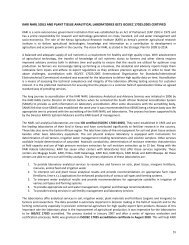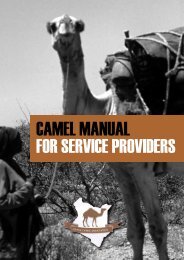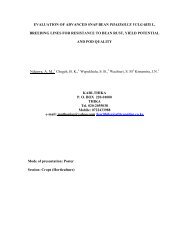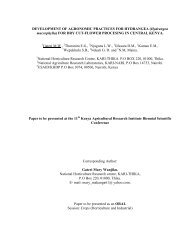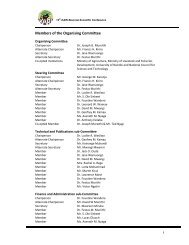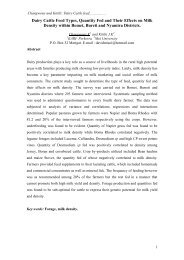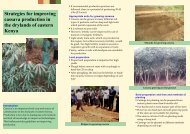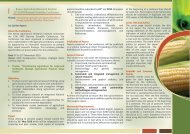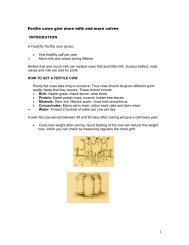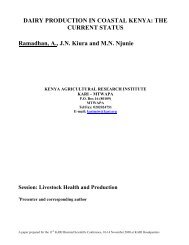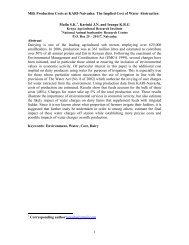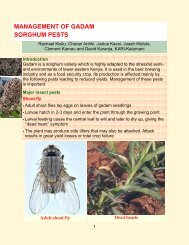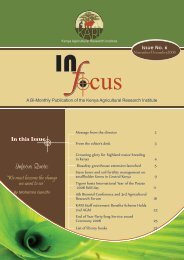January - June 2008 - Kenya Agricultural Research Institute
January - June 2008 - Kenya Agricultural Research Institute
January - June 2008 - Kenya Agricultural Research Institute
Create successful ePaper yourself
Turn your PDF publications into a flip-book with our unique Google optimized e-Paper software.
Media Open Day for Smallholder Flower Growers:-A USAID-KHDP/KARI/MOA Initiative<br />
By Alice Nakhumicha Muriithi and Charles Waturu, KARI-Thika<br />
Fresh flowers ready for harvesting and export<br />
KARI Thika in partnership with <strong>Kenya</strong> Horticultural<br />
Development Programme- USAID funded (KHDP)<br />
carried out a project to create a niche market, new<br />
product opportunities and improved production systems<br />
for the smallholder farmer. The goal was to provide yearround<br />
income from the supply of high quality products to<br />
domestic, regional and international markets. The KARI<br />
and KHDP missions have similarities in that they aspire<br />
to financially empower smallholder farmers through crop<br />
diversification, improvements in production and postharvest<br />
technologies, and market linkages in collaboration<br />
with their stakeholders. The Ministry of Agriculture (MOA)<br />
extension staff monitor the farmer’s adoption of<br />
technologies. The partnership between KARI-Thika and<br />
KHDP started in September 2004.<br />
KHDP hosted an open day for the media on 14 th<br />
February <strong>2008</strong> to show the impact of the USAID-KHDP/<br />
KARI/MOA Project on smallholder flower farmers. The<br />
field day included visits to KARI-Thika, Githunguri<br />
Sapewe Self Help group located at Githunguri sub-location,<br />
Kandara Division. The media team was led by Lydia<br />
Njuguna the technical manager from USAID-KHDP to<br />
trace the flower value chain. The tour at the Centre began<br />
with a courtesy call on the Centre Director, Dr. C.N. Waturu.<br />
The link between research and the growers was explained.<br />
The value chain for cut flower production begins with<br />
research on the new introduced crops to develop<br />
production and post harvest packages. At the experimental<br />
fields, the ornamental plants in production were observed<br />
and details given of the trials being carried out or<br />
achievements made with the particular crop. The flower<br />
crops included those under shade (50%) were leatherleaf<br />
fern which generates income as cut foliage for the fresh<br />
flower local market year- round. The team saw buyers come<br />
and harvest the foliage. Hydrangea was also another<br />
flower crop under the shade. Nutrition and spacing trials<br />
had been completed and recommendations made available<br />
to the farmers. Hydrangea is a popular processing flower<br />
for the Rosavie factory(Nairobi). Celosia was one of the<br />
flowers growing in the open field. Currently local and export<br />
market performance is being evaluated. Stachys is a new<br />
foliage plant grown in the open and disease problems<br />
have been observed. Control options for the fusarium and<br />
verticillum wilt are being investigated as this problem<br />
seems to develop during the second year of the crop when<br />
the splits from the existing crop are required for<br />
propagation. Pigeon peas are among the foliage plants<br />
for the processing industry. Current new varieties with<br />
the required characteristics for processing are being<br />
bulked for distribution to the farmers.<br />
Githunguri Sapewe Self Help group begun in 2005 at<br />
Githunguri Sub-Location of Kandara Division. The group<br />
was introduced to flower production by KARI through<br />
USAID/KHDP in March 2005. Mobydick was the first<br />
flower crop whose technology was disseminated through<br />
Farmer Field School (FFS) approach. Consequently, the<br />
farmers purchased and planted 3 kg of Mobydick seeds<br />
in their individual farms. The group was linked to a flower<br />
exporting agent for marketing of their flowers. By the end<br />
of 2005, flowers worth KES 348,000 were produced and<br />
sold. In 2006, the number of farmers in the area growing<br />
Mobydick increased tremendously. By the end of 2006,<br />
four flower companies were operating in the area and<br />
purchased flowers worth KES 620,000 due to improved<br />
farm gate prices (from KES 3 to 6). In <strong>January</strong> 2006 the<br />
group trained in nursery management, transplanting, crop<br />
protection and top-dressing of Zinnia flower crop. 1000<br />
plants of Zinnia were planted in the group’s demonstration<br />
plot. The group harvested and delivered 22,280 stems of<br />
Zinnia from the demonstration farm between March and<br />
May 2006, 9,677 stems were accepted at the market.<br />
Seedling selection emphasized as rejections were due to<br />
off types. Other crops that were introduced to the group<br />
through the USAID KHDP/KARI partnership include<br />
scabiosa, tagetes, gomphrena stachys and arabicum. The<br />
group has bulked enough seeds of zinnia, scabiosa and<br />
tagetes to grow in their individual farms. This group is<br />
indeed flowering the landscape and has reduced<br />
vulnerability to food insecurity in the village!<br />
The farmers in the SAPEWE group currently sell their<br />
fresh cut flowers to Wilmar (Thika). The flowers for<br />
processing are delivered directly to Rosavie in Nairobi.<br />
Dr. Waturu explains a point to Media at a Smallholder<br />
Flower Farm in Githunguri Sapewe<br />
Highlighter No. 23<br />
7



